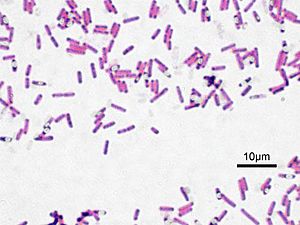Polyhydroxyalkanoate facts for kids

Polyhydroxyalkanoate (PHA) is a special material called a biopolymer. It is made by tiny living things called bacteria. What's cool about PHA is that it can break down naturally in the environment. This means it is biodegradable, just like food scraps or leaves.
PHA acts a lot like plastic, but it's much better for our planet. Regular plastics are made from oil, gas, or coal. These are called finite resources because they will eventually run out. PHA, however, is made from renewable resources. This means we can grow more of them, like sugar from crops. Some types of PHA feel like polypropylene, which is used to make strong ropes and packaging. Other types of PHA are soft and stretchy, similar to rubber.
Contents
What are PHAs?
PHAs are a group of natural materials. Bacteria create them inside their bodies. They store PHA as a way to save energy, much like how animals store fat. When the bacteria need energy, they can use the PHA. Scientists have found many different kinds of PHAs. Each kind has slightly different properties.
How Bacteria Make PHAs
Bacteria are amazing little factories. They can take simple sugars or other carbon sources and turn them into PHA. This process happens inside the bacterial cells. Scientists can grow large amounts of these bacteria in special tanks. They feed the bacteria sugar, and the bacteria then produce PHA. This is a very natural way to make materials.
Why PHAs are Important
PHAs are important because they offer a green solution to plastic pollution. Regular plastics can stay in the environment for hundreds of years. They break into tiny pieces called microplastics, which can harm animals and ecosystems. Since PHAs are biodegradable, they can break down into natural substances like water and carbon dioxide. This helps keep our planet cleaner and healthier.
Uses for PHAs
Because PHAs act like plastics but are biodegradable, they have many uses. Scientists and companies are always finding new ways to use them.
Packaging and Containers
One of the main uses for PHAs is in packaging. Imagine food containers, cups, or bags that can break down after you use them. This reduces waste in landfills. PHAs can be molded into many shapes. They are safe for food contact.
Medical Uses
PHAs are also used in medicine. They can be made into things that dissolve safely inside the body. For example, they might be used for stitches that disappear on their own. They can also be used for medical implants or drug delivery systems. This is because the body usually accepts them well.
Other Products
PHAs can be used to make many other items. This includes disposable cutlery, agricultural films, and even parts for electronics. Some companies are looking into using PHAs for 3D printing materials. This shows how versatile these natural polymers can be.
The Future of PHAs
The use of PHAs is growing. As people become more aware of environmental issues, the demand for eco-friendly materials increases. Scientists are working to make PHA production even more efficient. They are also trying to create new types of PHAs with even better properties. The goal is to make PHAs a common and affordable alternative to traditional plastics. This could help us build a more sustainable future.
Images for kids
See also
 In Spanish: Polihidroxialcanoato para niños
In Spanish: Polihidroxialcanoato para niños


